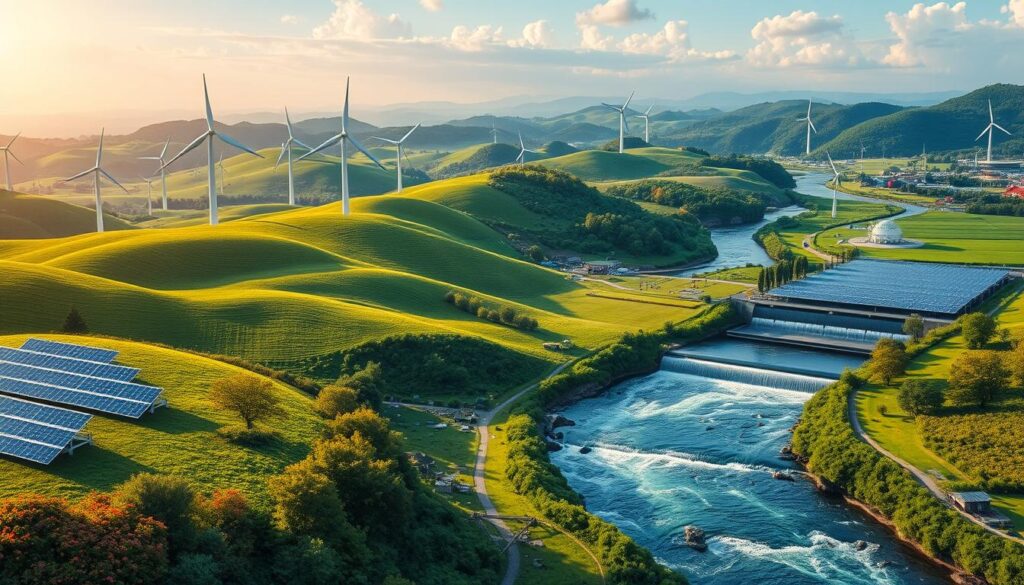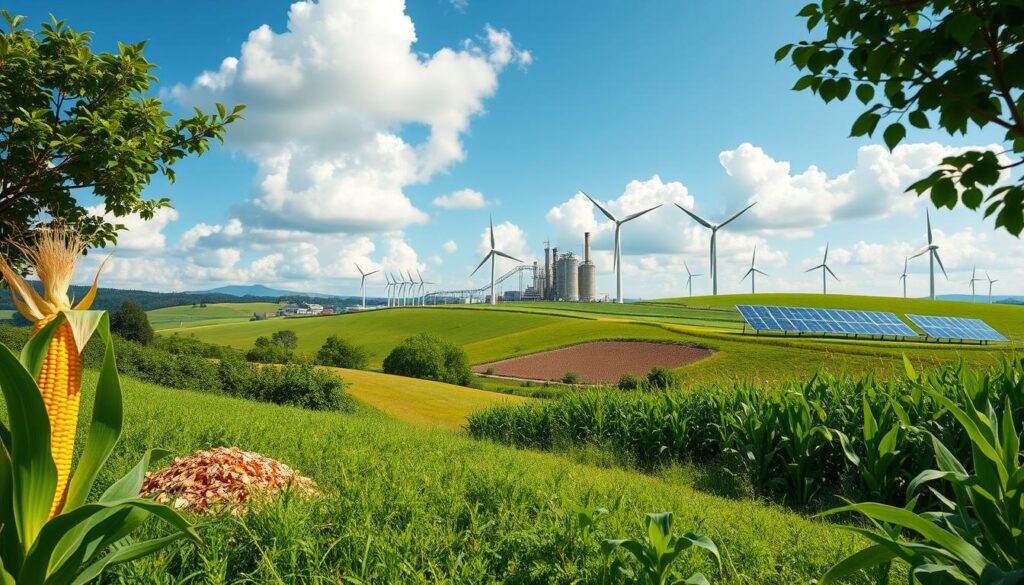The world faces urgent challenges from climate change and environmental degradation. A sustainable energy future is now more critical than ever. Renewable energy technologies offer a promising solution, leading to a cleaner, more resilient, and environmentally conscious energy landscape.
Renewable energy sources like solar, wind, hydroelectric, geothermal, and biomass provide clean, abundant, and inexhaustible alternatives to fossil fuels. These technologies are transforming energy generation, distribution, and consumption. They pave the way for a more sustainable future.

Key Takeaways
- Renewable energy technologies offer a sustainable solution to address climate change and environmental challenges.
- Renewable energy sources, including solar, wind, hydroelectric, geothermal, and biomass, provide clean, abundant, and inexhaustible energy alternatives.
- The transition to renewable energy is transforming the global energy landscape, promoting energy security, environmental protection, and economic growth.
- Advancements in renewable energy technologies are driving increased efficiency, cost-effectiveness, and grid integration, making them more accessible and viable for widespread adoption.
- Governments, businesses, and individuals are playing a crucial role in accelerating the adoption of renewable energy technologies to create a sustainable future.
Understanding Renewable Energy Technologies: The Path Forward
The world faces pressing challenges like climate change and environmental sustainability. Renewable energy technologies play a vital role in addressing these issues. They offer a clean solution to reduce our carbon footprint and ensure a sustainable future.
Defining Clean Energy Systems
Clean energy systems include various technologies that use renewable sources like solar, wind, hydroelectric, geothermal, and biomass. These systems generate electricity or heat without emitting harmful greenhouse gases. They are key to fighting climate change globally.
Environmental Benefits and Sustainability
The environmental benefits of renewable energy are clear. Switching to clean energy sources reduces our carbon emissions and global warming impact. These systems also preserve natural resources, reduce pollution, and support biodiversity. They are crucial for our planet’s long-term sustainability.
Economic Advantages of Renewables
Renewable energy technologies also have significant economic benefits. The cost of solar and wind energy has dropped, making them competitive with fossil fuels. They create jobs, boost local economies, and enhance energy security and independence.
| Renewable Energy Technology | Environmental Benefits | Economic Advantages |
|---|---|---|
| Solar Power | Reduced carbon emissions, no air or water pollution | Declining costs, job creation, energy independence |
| Wind Energy | Minimal environmental impact, conservation of natural resources | Competitive with fossil fuels, support for local economies |
| Hydroelectric Power | Renewable, emission-free energy generation | Reliable, long-term energy supply, cost-effective |
As we face the urgent need for sustainable energy, understanding and adopting renewable technologies is key. They will shape a greener, more prosperous future for everyone.
“Renewable energy technologies present a unique opportunity to address the global energy crisis while simultaneously mitigating the impact of climate change. By embracing these clean energy systems, we can pave the way for a more sustainable and prosperous future.”
Solar Power: Harnessing the Sun’s Unlimited Potential
In the rapidly evolving landscape of renewable energy technologies, solar power has emerged as a shining star. Solar power, harnessed through photovoltaic (PV) systems and solar thermal technologies, offers a sustainable solution to our energy demands.
Photovoltaic technology has undergone remarkable advancements, enabling the conversion of sunlight into clean, renewable electricity. These solar panels are becoming increasingly efficient, cost-effective, and accessible. They make them a viable option for both residential and commercial applications.
Complementing photovoltaic systems, solar thermal systems utilize the sun’s heat to generate thermal energy. This energy can be used for space heating, water heating, or even industrial processes. These systems leverage the direct application of solar energy, providing a versatile and eco-friendly alternative to traditional heating methods.
As the renewable energy technologies continue to evolve, solar power is poised to play an increasingly crucial role in the global energy landscape. With its abundant and renewable resource, solar energy holds the promise of a sustainable future. It empowers individuals, communities, and industries to harness the sun’s limitless potential.
“The sun, the moon, and the stars would have disappeared long ago… had they happened to be within the reach of predatory human hands.”
– Henry Ellis
Wind Energy: Powering Communities Through Natural Forces
Wind energy is a key player in the quest for a sustainable energy future. It taps into the natural forces that shape our planet. We explore the significant progress in onshore and offshore wind farms. We also look at how to integrate this renewable energy into our electrical grids.
Onshore Wind Farm Development
Onshore wind farms lead the way in wind energy growth. They attract both policymakers and energy consumers. Advances in blade design and tower engineering boost their efficiency. Strategically placed, these farms harness consistent winds, benefiting communities with clean energy.
Offshore Wind Technology Advances
The offshore wind sector has seen rapid innovation. Floating wind turbines and deep-water foundations have transformed offshore energy harvesting. These technologies tap into the stronger, more consistent marine winds, complementing land-based farms.
Grid Integration Strategies
Integrating wind energy into grids is now a major focus. Advanced grid management, energy storage, and transmission upgrades ensure reliable power. These efforts make wind energy a seamless part of our power supply.
The future of wind energy is bright, with technology and planning driving progress. By leveraging natural forces, we can meet energy needs sustainably. This approach protects our environment for future generations.
“Wind is an abundant, renewable, and clean source of energy that has the potential to play a significant role in the global energy mix.” – International Energy Agency
Hydroelectric Power Generation Systems
The world is moving towards renewable energy, and hydroelectric power is leading the way. It’s a clean and efficient source of electricity. Hydroelectric systems use water’s natural flow to generate sustainable energy, making it crucial for renewable energy.
At the core of hydroelectric power are water turbines and dam systems. Large dams tap into the power of flowing water. Turbines turn this energy into electricity. This method is both eco-friendly and cost-effective, appealing to communities wanting to cut carbon emissions.
Yet, the hydroelectric power sector faces challenges. Building dams can harm local ecosystems and disrupt natural habitats. It’s vital to plan carefully to balance energy needs with environmental protection.
Despite these hurdles, hydroelectric power holds vast potential. Advances in renewable energy technologies are making hydroelectric systems more efficient and sustainable. As the demand for clean energy grows, hydroelectric power will be key in creating a greener future.

“Hydroelectric power is a renewable energy source that can provide clean, reliable, and cost-effective electricity for communities around the world.”
Geothermal Energy: Tapping Earth’s Internal Heat
The world’s move towards sustainability has made renewable energy technologies crucial. Geothermal energy, in particular, is a promising way to tap into the Earth’s heat. It offers a clean, reliable source of power, meeting the growing demand for sustainable energy.
Geothermal Plant Operations
Geothermal power plants harness the Earth’s heat to generate electricity. They use various technologies, from traditional steam turbines to advanced binary cycle systems. This makes them efficient and reliable, appealing to communities looking to cut carbon emissions.
Direct Use Applications
Geothermal energy also has practical uses beyond electricity. It can directly heat homes, businesses, and even greenhouses. This versatility makes geothermal energy a valuable renewable technology with many applications.
Enhanced Geothermal Systems
Enhanced geothermal systems (EGS) aim to unlock more potential in geothermal energy. They artificially enhance underground rock formations to improve fluid flow and thermal energy extraction. EGS technology could make geothermal power more accessible, even in areas with limited natural resources.
As the world shifts towards renewable energy, geothermal energy is a key player in a greener future. Advancements in plant operations, direct use, and EGS technology are set to unlock its full potential. This will be crucial in the years ahead.
| Geothermal Plant Type | Efficiency | Advantages | Disadvantages |
|---|---|---|---|
| Dry Steam | 15-20% | Simplest design, lower operation and maintenance costs | Requires high-temperature resources, limited availability |
| Flash Steam | 20-25% | Suitable for moderate-temperature resources, more efficient than dry steam | More complex design, requires water management |
| Binary Cycle | 10-15% | Can utilize lower-temperature resources, more flexible design | Lower overall efficiency, higher capital costs |
Biomass and Biofuel Technologies
In our quest for a sustainable future, renewable energy technologies have become crucial. Biomass and biofuel technologies are at the forefront, offering innovative ways to utilize organic matter. Derived from plants and animals, biomass can be transformed into heat, electricity, and fuels for transportation.
The conversion of biomass into energy involves transforming organic matter into usable forms. This can be done through combustion, gasification, or anaerobic digestion. These methods not only produce renewable energy but also help in the circular economy by reusing waste materials.
Diverse Biomass Feedstocks
Biomass feedstocks vary widely, including:
- Lignocellulosic materials (such as wood, straw, and energy crops)
- Agricultural residues (such as corn stover and sugarcane bagasse)
- Aquatic biomass (such as algae and seaweed)
- Animal waste (such as manure and food processing byproducts)
These diverse sources provide a renewable energy option, enhancing the sustainability of renewable energy.
Biofuel Production and Applications
Biofuels, like ethanol and biodiesel, are made from biomass through fermentation, transesterification, and pyrolysis. They serve as alternatives to fossil fuels, cutting down on greenhouse gas emissions. This makes them a cleaner energy choice for transportation and other uses.
| Biofuel Type | Feedstock | Conversion Process | Applications |
|---|---|---|---|
| Ethanol | Corn, sugarcane, lignocellulosic biomass | Fermentation | Blended with gasoline for transportation |
| Biodiesel | Vegetable oils, animal fats, waste cooking oil | Transesterification | Blended with diesel fuel for transportation |
| Biogas | Organic waste, agricultural residues, animal manure | Anaerobic digestion | Electricity and heat generation, transportation fuel |
As the renewable energy sector grows, biomass and biofuel technologies remain key solutions. They meet the increasing demand for sustainable energy sources.

Marine Energy: Harnessing Tidal and Wave Power
The world’s shift towards sustainability has highlighted marine energy as a key renewable source. This includes tidal, wave, and ocean thermal energy conversion. These methods use the ocean’s natural forces to produce electricity.
Tidal Stream Technologies
Tidal stream technologies harness the tidal currents to power turbines and generate electricity. They are set up in coastal areas with strong tidal flows. This makes them a reliable power source. Their scalability allows for large tidal power plants, capable of powering communities.
Wave Energy Converters
Wave energy converters tap into ocean waves to produce electricity. They can be placed offshore or near the shore. Designs vary, including point absorbers and oscillating wave surge converters. The oceans hold vast wave power resources, making this a promising area.
Ocean Thermal Energy Conversion
Ocean thermal energy conversion (OTEC) uses the ocean’s temperature difference to generate electricity. It leverages the warm surface waters against the cold deep waters. This makes OTEC highly efficient and renewable, especially in tropical and subtropical areas.
Marine energy technologies are crucial for the future of renewable energy. They offer a clean, sustainable energy source from tides, waves, and thermal gradients. This could lead to a greener, more secure energy future.
Emerging Technologies in Renewable Energy Storage
The shift towards a sustainable energy future highlights the critical need for efficient energy storage. Advanced battery systems and hydrogen fuel cells are key to grid stability and reliability. They also unlock the full potential of solar and wind energy, which are intermittent.
Advancements in battery technology, such as lithium-ion, flow batteries, and solid-state designs, are underway. These improvements aim to boost energy density, reduce charging times, and extend battery life. This enables large-scale energy storage systems to work in harmony with renewable power plants. As a result, clean electricity is consistently supplied to the grid.
Hydrogen fuel cells represent a promising avenue for long-duration energy storage. They convert excess renewable energy into hydrogen, which can be stored for long periods. This stored energy can then be converted back into electricity or used to power vehicles. As renewable energy technologies advance, hydrogen-based storage solutions will be essential for a sustainable, resilient energy system.
